A Compact Dual-Polarized Vivaldi Antenna with High Gain for Tree Radar Applications
Abstract
1. Introduction
- Many approaches have been proposed to achieve gain enhancement for Vivaldi antennas, but they may cause a sacrifice in the antenna size and the operating frequency range. Zero-index metamaterial arrays are introduced to adjust the refraction index to mitigate reflections [14,15], but they are only effective over a limited bandwidth. Besides, the size of the metamaterial depends on the operating frequency and becomes excessively large at low frequencies. Although dielectric lenses [16] are added to correct the phase errors, they come with a sacrifice of a large antenna size. While double-slot Vivaldi antennas and elliptical slot edges are proposed in [14,16], these techniques often increase the antenna size and/or decrease the operating bandwidth.
- Existing dual-polarized Vivaldi antennas have limited gain performance and port isolation. They are commonly realized via a cross-shape configuration, where two elements are orthogonally inserted into each other [11,17,18]. The port isolation and gain performance of these antennas are around 20 dB and 5.5 dBi, respectively, which still indicates room for improvement. Besides, such a configuration requires careful design of the feeding structure since they interact with each other.
- Antenna miniaturization for Vivaldi antennas usually comes with gain reduction and a sacrifice in radiation efficiency. To reduce the antenna size, exponential strip arms [19] are implemented to extend the low-end operating frequency without increasing the size. The exponential strip arms act like dipole antennas, introducing more frequency resonances and widening the frequency range. However, this enhancement causes a decrease in the gain performance. Loading resistance is another option [20], but the resistor reduces the radiation efficiency. A coplanar waveguide with a specifically designed feeding structure [21] helps in miniaturization, but the size of the antenna remains around half of the wavelength at the lowest frequency, limiting the portability of the radar system in practical applications.
2. Antenna Design Principles
2.1. The Shared-Aperture Configuration
2.2. The Design of Directors
2.3. The Design of Slots
2.4. The Metal Reflector
3. Antenna Performance
4. Tree Trunk Scanning Validation
5. Conclusions
Author Contributions
Funding
Institutional Review Board Statement
Informed Consent Statement
Data Availability Statement
Conflicts of Interest
References
- Ježová, J.; Mertens, L.; Lambot, S. Ground-penetrating radar for observing tree trunks and other cylindrical objects. Constr. Build. Mater. 2016, 123, 214–225. [Google Scholar] [CrossRef]
- Giannakis, I.; Tosti, F.; Lantini, L.; Alani, A.M. Health monitoring of tree trunks using ground penetrating radar. IEEE Trans. Geosci. Remote Sens. 2019, 57, 8317–8326. [Google Scholar] [CrossRef]
- Giannakis, I.; Tosti, F.; Lantini, L.; Alani, A.M. Diagnosing emerging infectious diseases of trees using ground penetrating radar. IEEE Trans. Geosci. Remote Sens. 2019, 58, 1146–1155. [Google Scholar] [CrossRef]
- Dai, Q.; Wen, B.; Lee, Y.H.; Yucel, A.C.; Ow, G.; Yusof, M.L.M. A Deep Learning-Based Methodology for Rapidly Detecting the Defects inside Tree Trunks via GPR. In Proceedings of the 2020 IEEE USNC-CNC-URSI North American Radio Science Meeting (Joint with AP-S Symposium), Toronto, ON, Canada, 5–10 July 2020; IEEE: New York, NY, USA, 2020; pp. 139–140. [Google Scholar]
- Qian, J.; Lee, Y.H.; Lee, D.; Yusof, M.L.M.; Yucel, A.C. A Signal Processing Framework for Rapid Detection of Tree Defects via a Standoff Tree Radar System. In Proceedings of the 2023 IEEE International Symposium on Antennas and Propagation and USNC-URSI Radio Science Meeting (USNC-URSI), Portland, OR, USA, 23–28 July 2023; IEEE: New York, NY, USA, 2023; pp. 345–346. [Google Scholar]
- Tahar, Z.; Dérobert, X.; Benslama, M. An ultra-wideband modified vivaldi antenna applied to through the ground and wall imaging. Prog. Electromagn. Res. C 2018, 86, 111–122. [Google Scholar] [CrossRef]
- Zou, L.; Tosti, F.; Alani, A.M. Nondestructive inspection of tree trunks using a dual-polarized ground-penetrating radar system. IEEE Trans. Geosci. Remote Sens. 2022, 60, 5917108. [Google Scholar] [CrossRef]
- Travassos, X.; Avila, S.; Adriano, R.D.S.; Ida, N. A review of ground penetrating radar antenna design and optimization. J. Microw. Optoelectron. Electromagn. Appl. 2018, 17, 385–402. [Google Scholar] [CrossRef]
- Ranga, Y.; Verma, A.K.; Esselle, K.P.; Hay, S.G. An ultra-wideband quasi-planar antenna with enhanced gain. Prog. Electromagn. Res. C 2014, 49, 59–65. [Google Scholar] [CrossRef][Green Version]
- Panzner, B.; Jöstingmeier, A.; Omar, A. A compact double-ridged horn antenna for ground penetrating radar applications. In Proceedings of the 18th International Conference on Microwaves, Radar and Wireless Communications, Vilnius, Lithuania, 14–16 June 2010; IEEE: New York, NY, USA, 2010; pp. 1–4. [Google Scholar]
- Dzagbletey, P.A.; Shim, J.-Y.; Chung, J.-Y. Quarter-wave balun fed Vivaldi antenna pair for V2X communication measurement. IEEE Trans. Antennas Propag. 2019, 67, 1957–1962. [Google Scholar] [CrossRef]
- Sun, H.-H.; Lee, Y.H.; Luo, W.; Ow, L.F.; Yusof, M.L.M.; Yucel, A.C. Compact dual-polarized vivaldi antenna with high gain and high polarization purity for GPR applications. Sensors 2021, 21, 503. [Google Scholar] [CrossRef]
- Hu, R.; Zhang, F.; Ye, S.; Fang, G. Ultra-Wideband and High-Gain Vivaldi Antenna with Artificial Electromagnetic Materials. Micromachines 2023, 14, 1329. [Google Scholar] [CrossRef]
- Zhu, S.; Liu, H.; Wen, P.; Du, L.; Zhou, J. A miniaturized and high gain double-slot Vivaldi antenna using wideband index-near-zero metasurface. IEEE Access 2018, 6, 72015–72024. [Google Scholar] [CrossRef]
- Sun, M.; Chen, Z.N.; Qing, X. Gain enhancement of 60-GHz antipodal tapered slot antenna using zero-index metamaterial. IEEE Trans. Antennas Propag. 2012, 61, 1741–1746. [Google Scholar] [CrossRef]
- Kang, X.; Li, Z. A modified UWB antipodal Vivaldi antenna with improved radiation characteristics. In Proceedings of the 2015 IEEE 6th International Symposium on Microwave, Antenna, Propagation, and EMC Technologies (MAPE), Shanghai, China, 28–30 October 2015; IEEE: New York, NY, USA, 2015; pp. 120–122. [Google Scholar]
- Adamiuk, G.; Zwick, T.; Wiesbeck, W. Compact, dual-polarized UWB-antenna, embedded in a dielectric. IEEE Trans. Antennas Propag. 2009, 58, 279–286. [Google Scholar] [CrossRef]
- Sonkki, M.; Sanchez-Escuderos, D.; Hovinen, V.; Salonen, E.T.; Ferrando-Bataller, M. Wideband dual-polarized cross-shaped Vivaldi antenna. IEEE Trans. Antennas Propag. 2015, 63, 2813–2819. [Google Scholar] [CrossRef]
- Honari, M.M.; Ghaffarian, M.S.; Mirzavand, R. Miniaturized antipodal Vivaldi antenna with improved bandwidth using exponential strip arms. Electronics 2021, 10, 83. [Google Scholar] [CrossRef]
- Zhu, Y.; Su, D.; Xie, W.; Liu, Z.; Zuo, K. Design of a novel miniaturized Vivaldi antenna with loading resistance for ultra wideband (UWB) applications. Appl. Comput. Electromagn. Soc. J. (ACES) 2017, 32, 895–900. [Google Scholar]
- Wang, Z.; Yin, Y.; Wu, J.; Lian, R. A miniaturized CPW-fed antipodal Vivaldi antenna with enhanced radiation performance for wideband applications. IEEE Antennas Wirel. Propag. Lett. 2015, 15, 16–19. [Google Scholar] [CrossRef]
- Cheng, K.; Lee, Y.H.; Lee, D.; Yusof, M.L.M.; Yucel, A.C. A Dual-Polarized Vivaldi Antenna for Tree Radar Applications. In Proceedings of the 2023 IEEE International Symposium on Antennas and Propagation and USNC-URSI Radio Science Meeting (USNC-URSI), Portland, OR, USA, 23–28 July 2023; IEEE: New York, NY, USA, 2023; pp. 1533–1534. [Google Scholar]
- Kojima, N.; Miyazaki, K. Considerations for Mutual Coupling and Mutual Radiation Resistance of Array Antenna. In Proceedings of the 2023 17th European Conference on Antennas and Propagation (EuCAP), Florence, Italy, 26–31 March 2023; IEEE: New York, NY, USA, 2023; pp. 1–5. [Google Scholar]
- Li, J.; Huang, J.; He, H.; Wang, Y. A High-Gain Metallic-via-Loaded Antipodal Vivaldi Antenna for Millimeter-Wave Application. Electronics 2024, 13, 1898. [Google Scholar] [CrossRef]
- Lai, K.Y.A. A Novel Antenna for Ultra-Wideband Applications; The Ohio State University: Columbus, OH, USA, 1990. [Google Scholar]
- Bai, J.; Shi, S.; Prather, D.W. Modified compact antipodal Vivaldi antenna for 4–50-GHz UWB application. IEEE Trans. Microw. Theory Tech. 2011, 59, 1051–1057. [Google Scholar] [CrossRef]
- Lv, H.; Huang, Q.; Hou, J.; Liu, J. Wideband dual-polarized Vivaldi antenna with gain enhancement. Appl. Comput. Electromagn. Soc. J. (ACES) 2018, 33, 990–996. [Google Scholar]
- Plettemeier, D.; Balling, S.; Benedix, W.S.; Ciarletti, V.; Hamran, S.E.; Corbel, C.; Linke, S. Ultra light-weight antenna system for full polarimetric GPR applications. In IEEE EUROCON; IEEE: New York, NY, USA, 2009; pp. 1557–1564. [Google Scholar]
- Qian, J.; Lee, Y.H.; Cheng, K.; Dai, Q.; Yusof, M.L.M.; Lee, D.; Yucel, A.C. A Deep Learning-Augmented Stand-off Radar Scheme for Rapidly Detecting Tree Defects. IEEE Trans. Geosci. Remote Sens. 2024, 62, 5106915. [Google Scholar] [CrossRef]
- Chen, C.; Huang, C.; He, Z.; Liu, T.; Song, X.; Su, Y. Combining dual-frequency cancellation and sparse feature enhancement for nonplanar surface clutter mitigation in holographic subsurface imaging. IEEE Trans. Geosci. Remote Sens. 2022, 60, 5111914. [Google Scholar] [CrossRef]
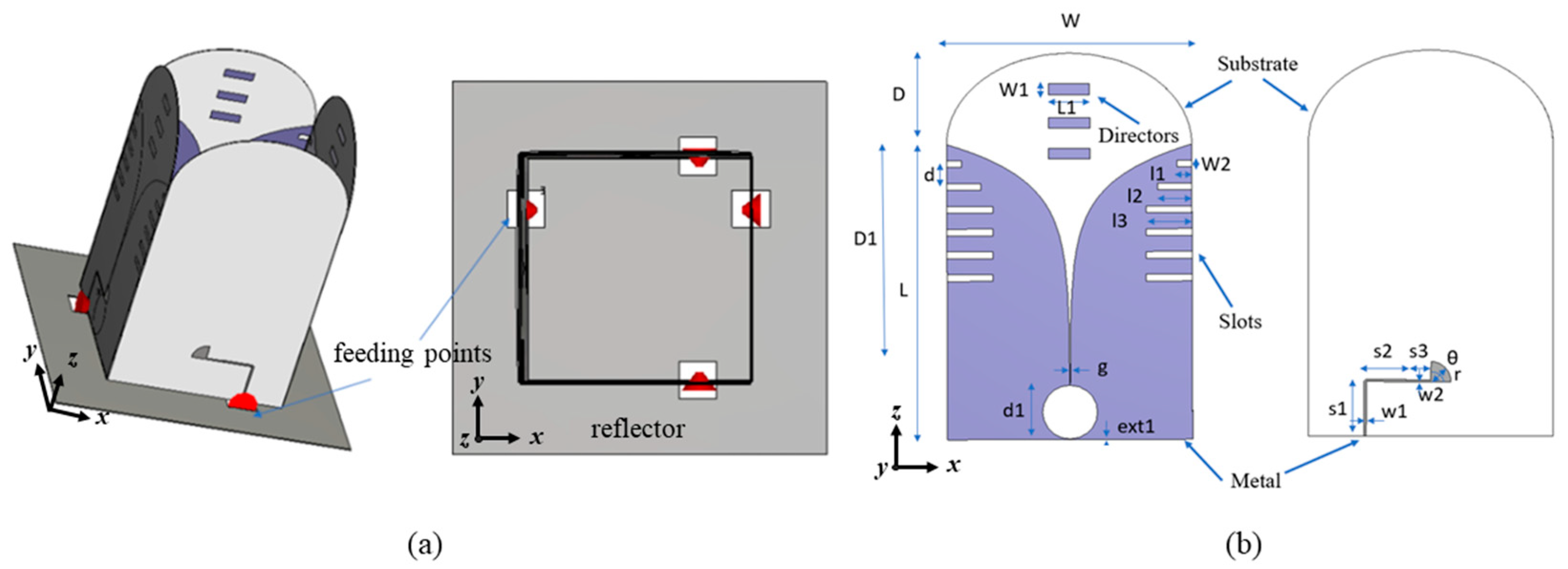

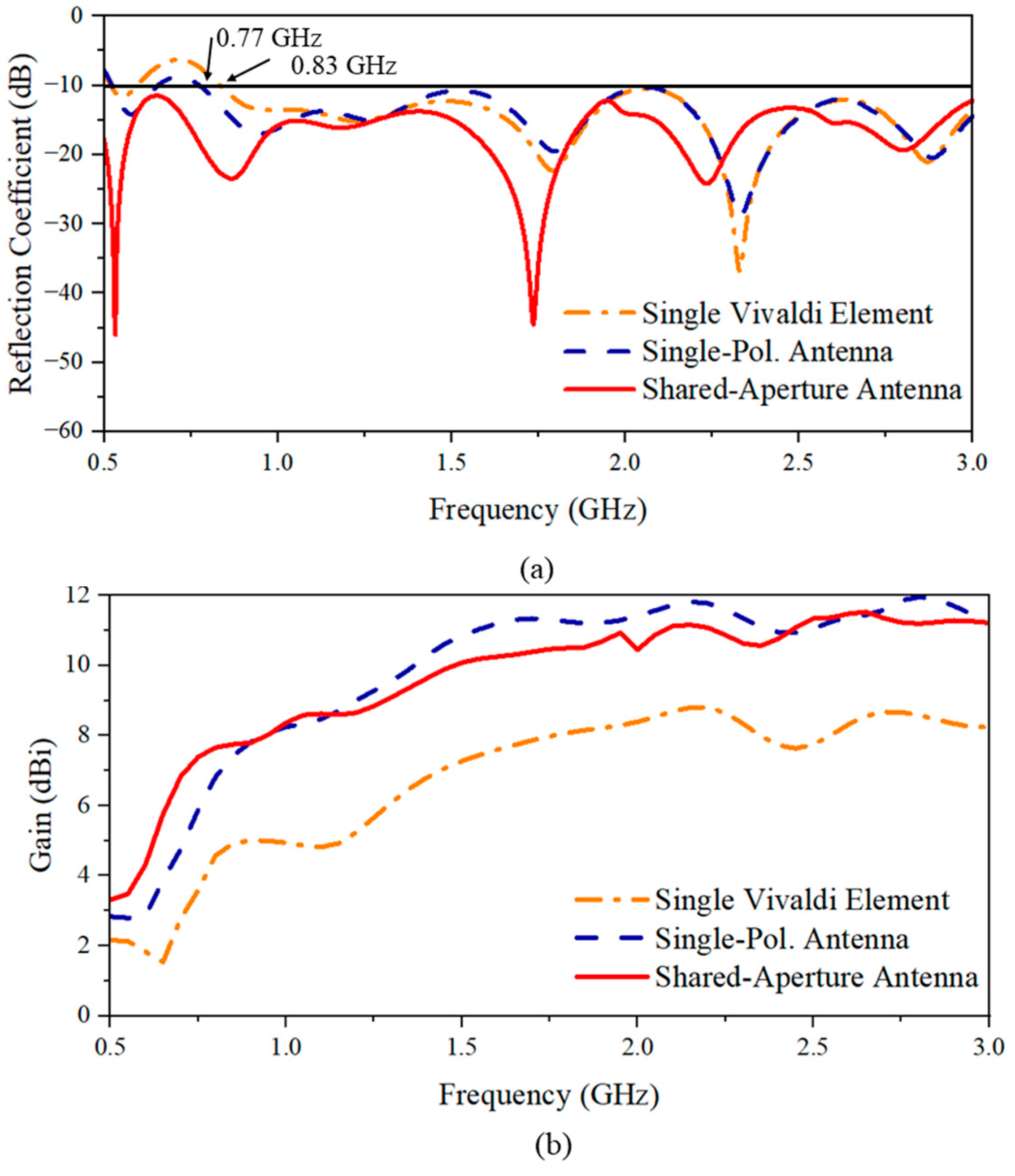
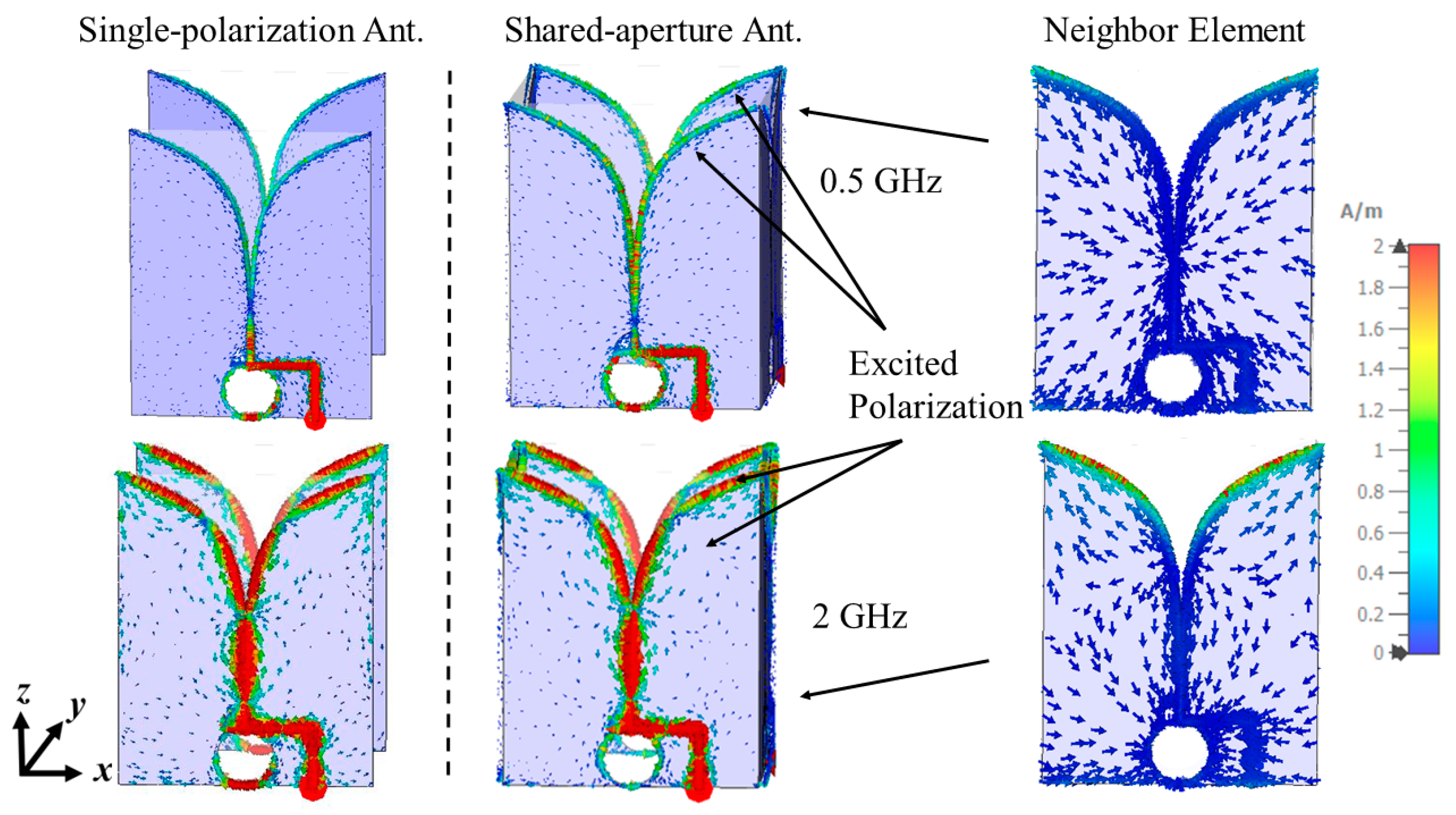

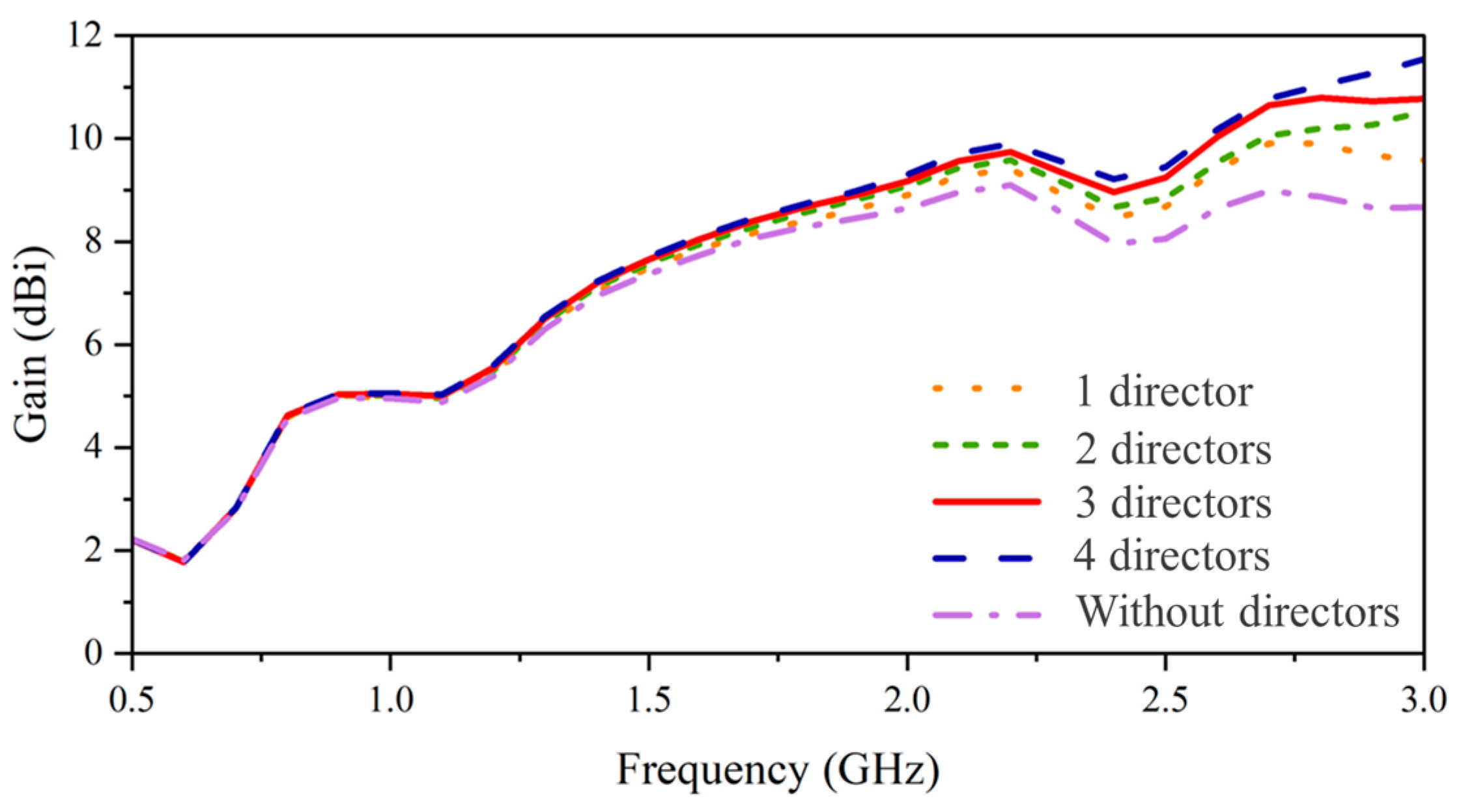



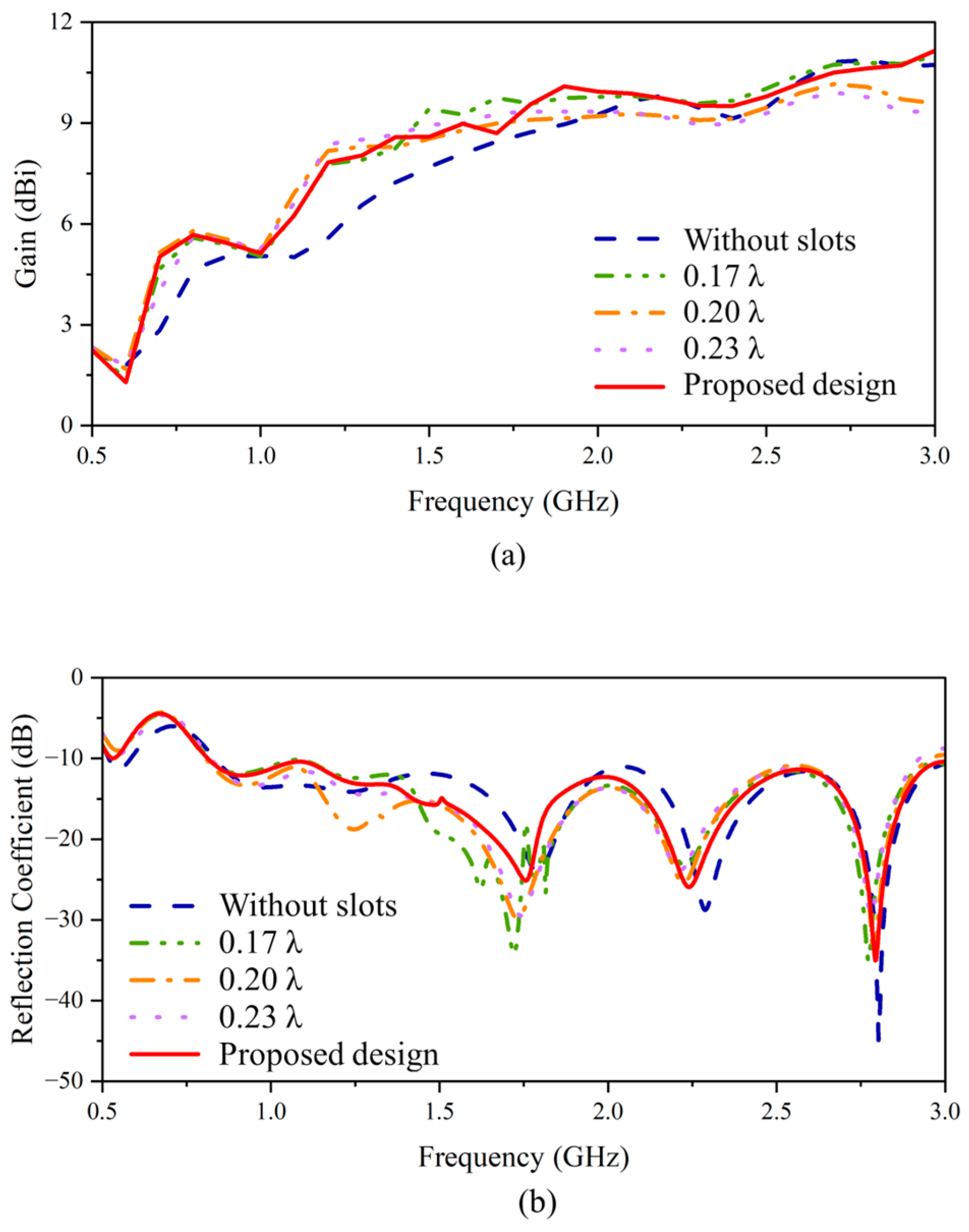

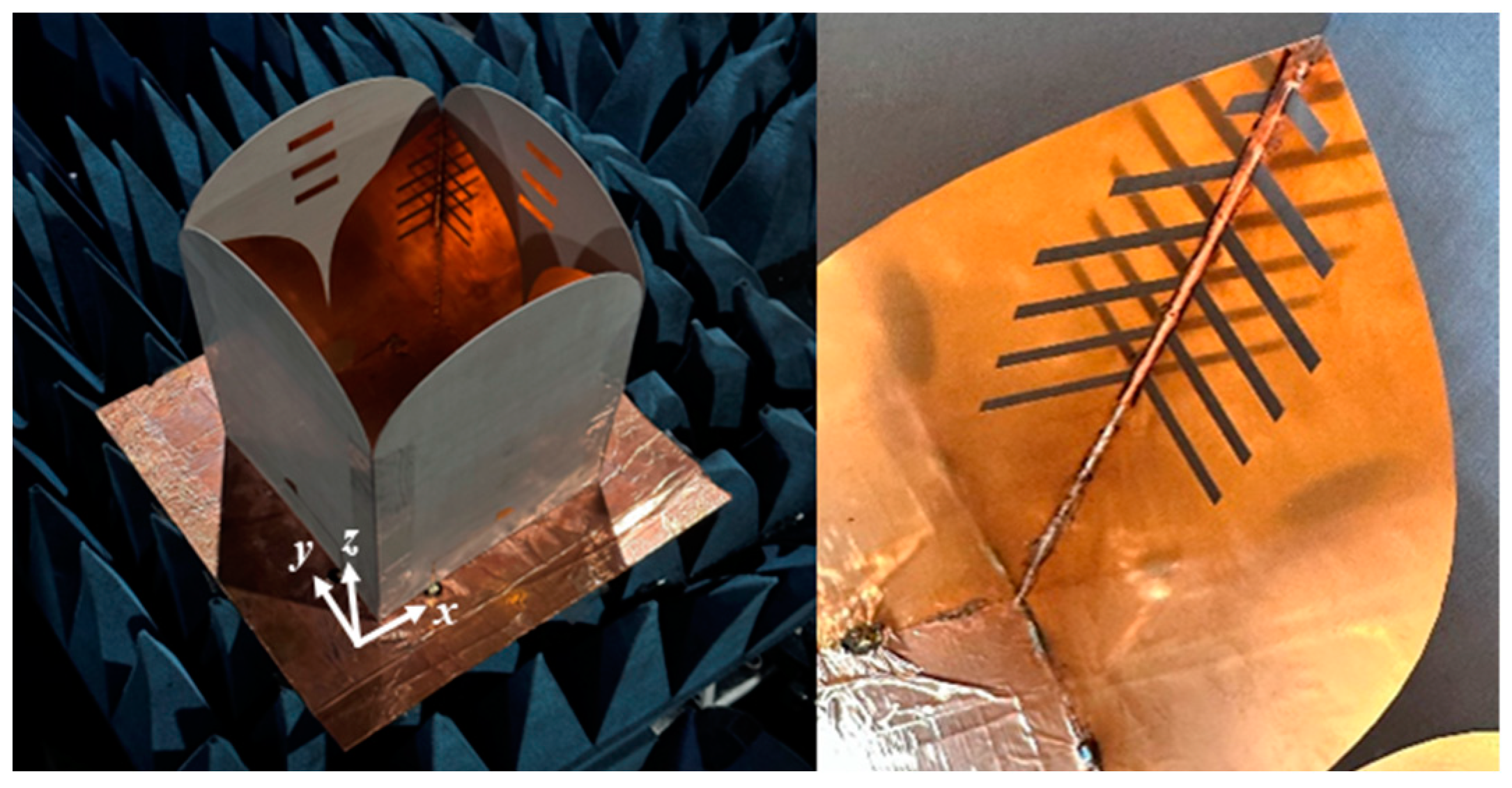

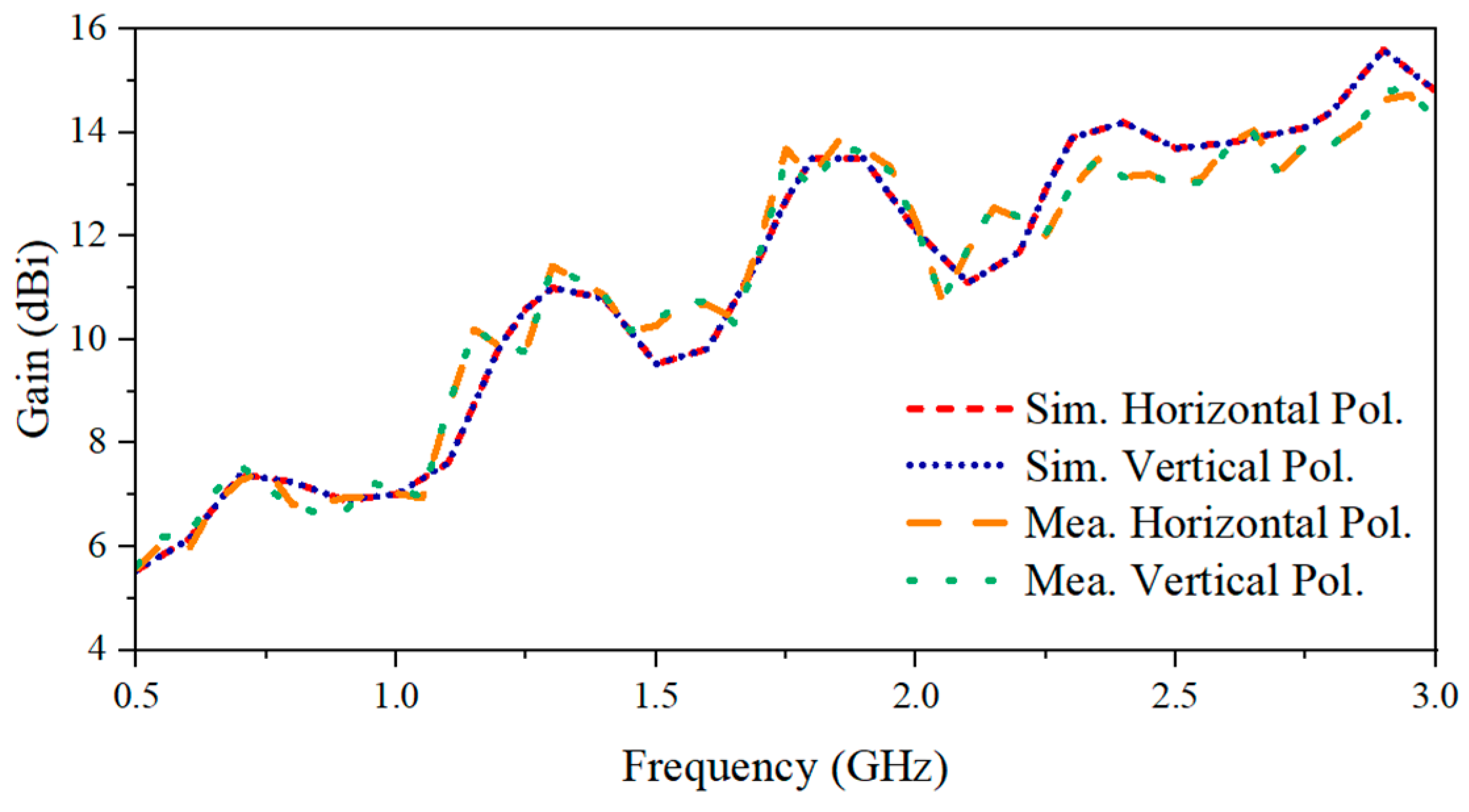
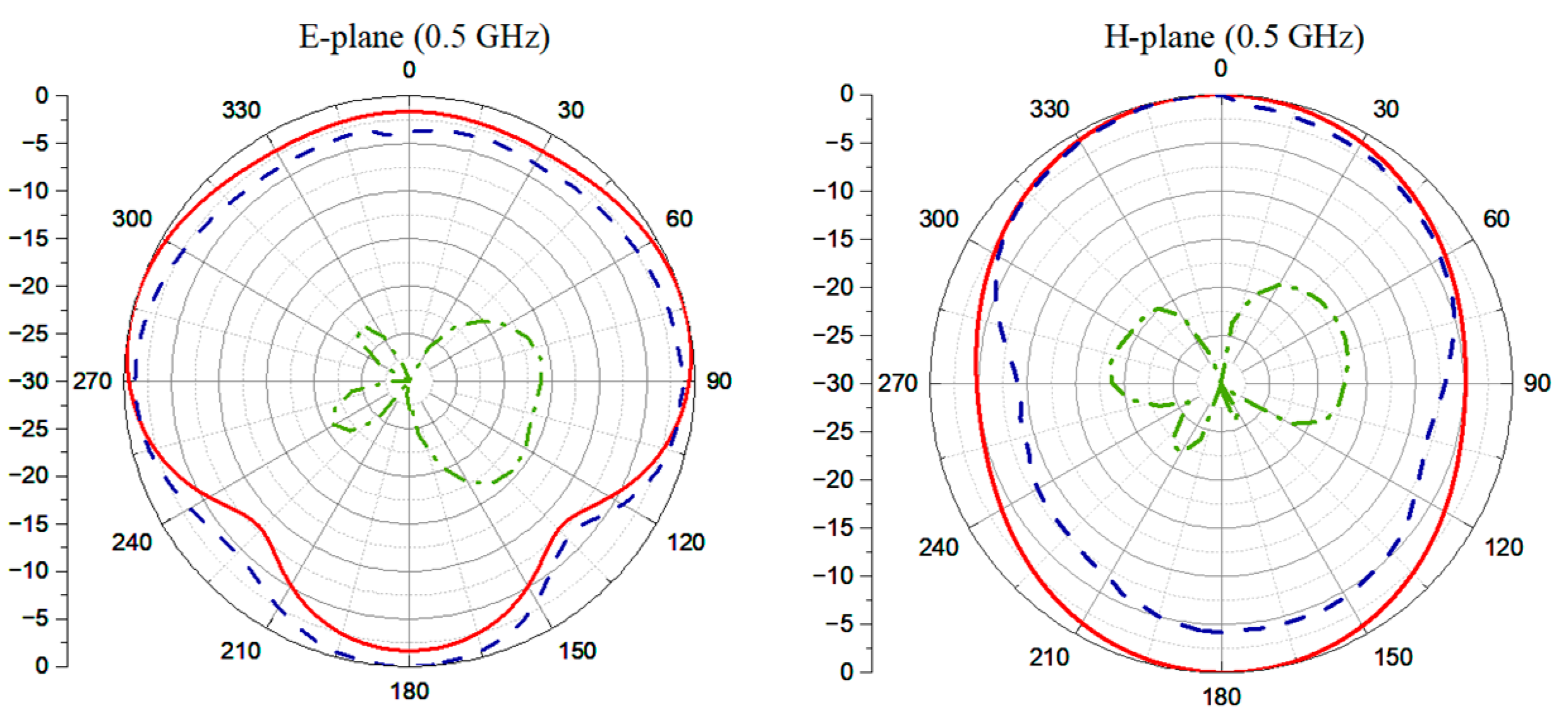




| Symbol | Parameter | Symbol | Parameter | Symbol | Parameter |
|---|---|---|---|---|---|
| W | 178.5 | g | 0.1 | r | 15 |
| D | 68 | d1 | 40 | θ | 88 |
| D1 | 178.5 | ext1 | 0.1 | l1 | 11 |
| L | 220 | s1 | 40.5 | l2 | 25 |
| W1 | 8 | s2 | 29.2 | l3 | 33.55 |
| L1 | 30 | s3 | 17.75 | w2 | 1.2 |
| d | 12 | w1 | 1.8 | W2 | 5 |
| Ref. | Freq. (GHz)/fBW | Isolation (dB) | XPD (dB) | Gain (dBi) | 3 dB Beamwidth at 1 GHz (°) | Size (λ3) |
|---|---|---|---|---|---|---|
| [11] | 0.56–7.7/173% | 28 | 17.2 | 1.2–9.2 | 90 | 0.24 × 0.24 × 0.35 |
| [12] | 0.4–4/164% | 40 | 23 | 4–12 | NG | 0.28 × 0.28 × 0.2 |
| [27] | 1.85–18.3/163% | 22 | 16.5 | 4–11.3 | NA | 0.36 × 0.36 × 0.9 |
| [17] | 3.1–10.6/109% | 20 | 15 | Max. 10 | NA | 0.36 × 0.36 × 0.55 |
| [28] | 0.5–3/143% | 15 | NG | 1–8.6 | >120 | 0.33 × 0.33 × 0.3 |
| [13] | 0.9–4/126% | NG | NG | 6.7–15.2 | 100 | 0.72 × 0.72 × 0.86 |
| Ant. | 0.5–3/143% | 30 | 20 | 5.5–14.8 | 90 | 0.29 × 0.29 × 0.48 |
| B-Scan | Migrated Image | |
|---|---|---|
| SCNR (dB) (⬆) | RMS (⬆) | |
| Proposed Vivaldi Antenna | 6.34 | 0.1371 |
| Commercial Horn Antenna | −5.19 | 0.1102 |
Disclaimer/Publisher’s Note: The statements, opinions and data contained in all publications are solely those of the individual author(s) and contributor(s) and not of MDPI and/or the editor(s). MDPI and/or the editor(s) disclaim responsibility for any injury to people or property resulting from any ideas, methods, instructions or products referred to in the content. |
© 2024 by the authors. Licensee MDPI, Basel, Switzerland. This article is an open access article distributed under the terms and conditions of the Creative Commons Attribution (CC BY) license (https://creativecommons.org/licenses/by/4.0/).
Share and Cite
Cheng, K.; Lee, Y.H.; Qian, J.; Lee, D.; Yusof, M.L.M.; Yucel, A.C. A Compact Dual-Polarized Vivaldi Antenna with High Gain for Tree Radar Applications. Sensors 2024, 24, 4170. https://doi.org/10.3390/s24134170
Cheng K, Lee YH, Qian J, Lee D, Yusof MLM, Yucel AC. A Compact Dual-Polarized Vivaldi Antenna with High Gain for Tree Radar Applications. Sensors. 2024; 24(13):4170. https://doi.org/10.3390/s24134170
Chicago/Turabian StyleCheng, Kaixuan, Yee Hui Lee, Jiwei Qian, Daryl Lee, Mohamed Lokman Mohd Yusof, and Abdulkadir C. Yucel. 2024. "A Compact Dual-Polarized Vivaldi Antenna with High Gain for Tree Radar Applications" Sensors 24, no. 13: 4170. https://doi.org/10.3390/s24134170
APA StyleCheng, K., Lee, Y. H., Qian, J., Lee, D., Yusof, M. L. M., & Yucel, A. C. (2024). A Compact Dual-Polarized Vivaldi Antenna with High Gain for Tree Radar Applications. Sensors, 24(13), 4170. https://doi.org/10.3390/s24134170








